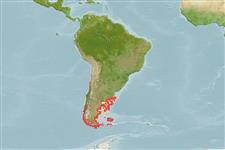Ensis macha (Molina, 1782)
Razor clam| Native range | All suitable habitat | Point map | Year 2050 |

|
| This map was computer-generated and has not yet been reviewed. |
| Ensis macha AquaMaps Data sources: GBIF OBIS |
Google image | No image available for this species;
drawing shows typical species in Pharidae.
Classification / Names Common names | Synonyms | CoL | ITIS | WoRMS
Bivalvia | Adapedonta | Pharidae
Environment: milieu / climate zone / depth range / distribution range Ecology
Benthic; depth range 0 - 55 m (Ref. 82660). Temperate; 19°S - 57°S, 76°W - 56°W
Distribution Countries | FAO areas | Ecosystems | Occurrences | Introductions
Southern Pacific (27 to 55°S) and Atlantic (40 to 50°S): Chile and Argentina. Subtropical to temperate.
Length at first maturity / Size / Weight / Age
Maturity: Lm ? range ? - ? cm Max length : 16.5 cm SHL male/unsexed; (Ref. 122430)
Life cycle and mating behavior Maturity | Reproduction | Spawning | Eggs | Fecundity | Larvae
Main reference
References | Coordinator | Collaborators
Barón, P.J., L.E. Real, N.F. Ciocco and M.E. Ré. 2004 Morphology, growth and reproduction of an Atlantic population of the razor clam Ensis macha (Molina, 1782). Scientia Marina 68(2):211-217. (Ref. 2805)
IUCN Red List Status
(Ref. 130435: Version 2025-1)
CITES status (Ref. 108899)
CMS (Ref. 116361)
Threat to humans
Human uses
Fisheries: commercial
| FishSource |
Tools
More information
Max. ages / sizes
Length-weight rel.
Length-length rel.
Length-frequencies
Mass conversion
Abundance
Internet sources
BHL | BOLD Systems | CISTI | DiscoverLife | FAO(Publication : search) | Fishipedia | GenBank (genome, nucleotide) | GloBI | Gomexsi | Google Books | Google Scholar | Google | PubMed | Tree of Life | Wikipedia (Go, Search) | Zoological Record



